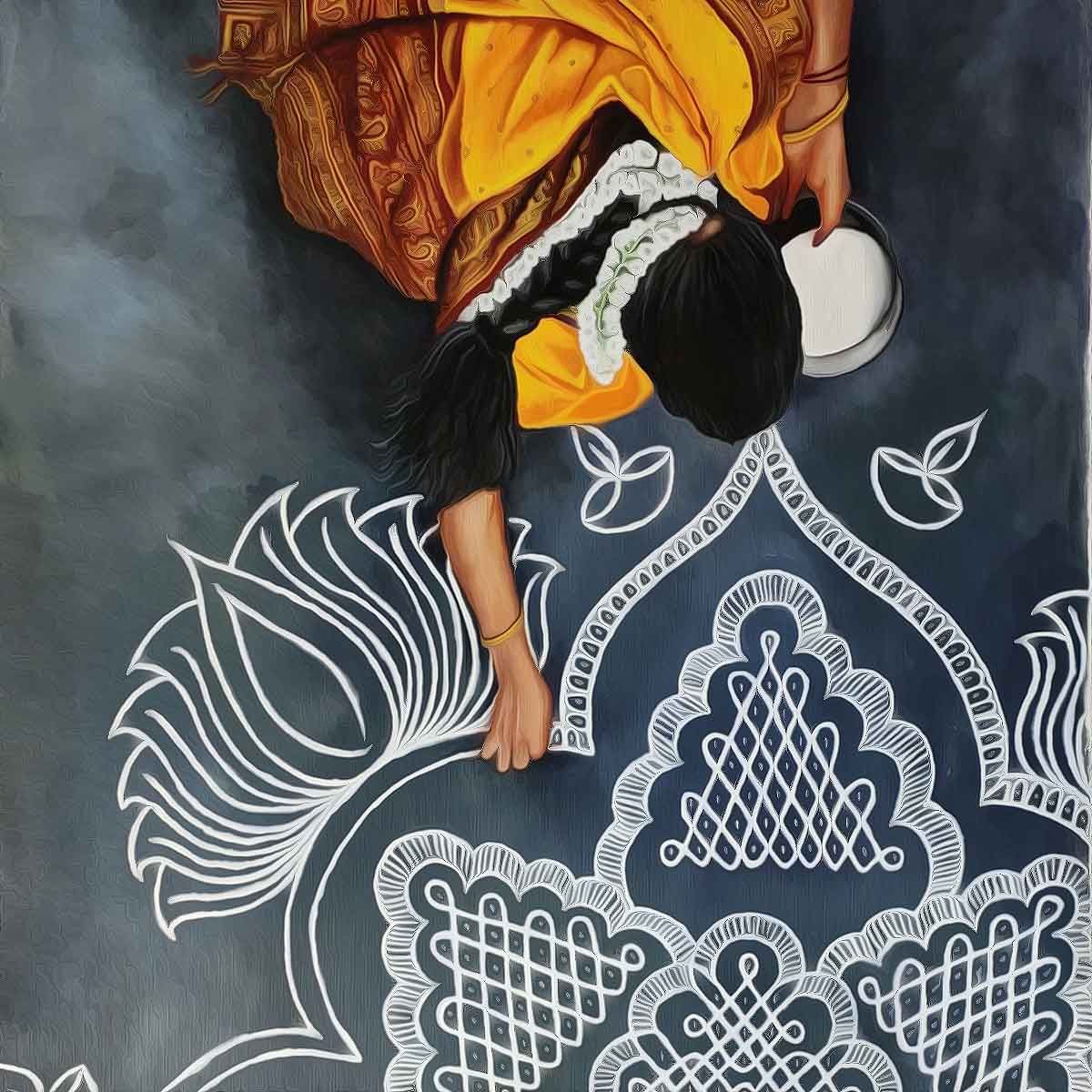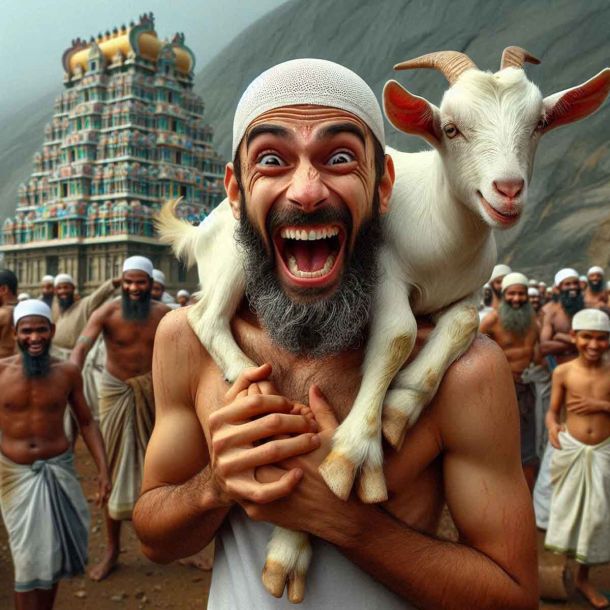More Coverage
Twitter Coverage
Satyaagrah
Written on
Satyaagrah
Written on
Satyaagrah
Written on
Satyaagrah
Written on
Satyaagrah
Written on
Join Satyaagrah Social Media
"Function of ritual is to give form to human life, not in mere surface, but in depth": Kōlams - traditional Indian Patterns that combine Art, Mathematics & Magic, and refers to the belief that Hindus have a “karmic obligation” to “feed a thousand souls”

BEFORE THE FIRST RAYS OF sunlight stream across the rice fields and mud roads in the Nilgiri Mountains, before they force their way through the high-rises in the urban jungle of Chennai and Madurai, the women of Tamil Nadu are up for the day. In the dark, they clean the threshold to their home, and, following a centuries-long tradition, painstakingly draw beautiful, ritualistic designs called kōlam, using rice flour.
|
Taking a clump of rice flour in a bowl (or a coconut shell), the kōlam artist steps onto her freshly washed canvas: the ground at the entrance of her house, or any patch of floor marking an entrypoint. Working swiftly, she takes pinches of rice flour and draws geometric patterns: curved lines, labyrinthine loops around red or white dots, hexagonal fractals, or floral patterns resembling the lotus, a symbol of the goddess of prosperity, Lakshmi, for whom the kōlam is drawn as a prayer in illustration. The making of the kōlam itself is a performance of supplication. The artist folds her body in half, bending at the waist, stooping to the ground as she fills out her patterns. Many kōlam artists see the kōlam as an offering to the earth goddess, Bhūdevi, as well.
But the kōlam is not just a prayer; it is also a metaphor for coexistence with nature. In her 2018 book, Feeding a Thousand Souls: Women, Ritual and Ecology in India, an Exploration of the Kōlam, Vijaya Nagarajan, a professor in the Department of Theology and Religious Studies at the University of San Francisco, refers to the belief in Hindu mythology that Hindus have a “karmic obligation” to “feed a thousand souls,” or offer food to those that live among us. By providing a meal of rice flour to bugs, ants, birds, and insects, she writes, the Hindu householder begins the day with “a ritual of generosity,” with a dual offering to divinity and to nature.
|
The word kōlam means beauty. What it also embodies is a perfect symmetry of straight or curved lines built around or through a grid of dots. Nearly always, the grid of dots comes first, requiring spatial precision to achieve symmetry. The dot in Hindu philosophy represents the point at which creation begins—it is a symbol of the cosmos. No tools other than the maker’s deft fingers, and the rice flour, are used. Sometimes the designs are one continuous line that loops over itself, snaking to infinity. Intersecting into infinite figure eights, in a style known as pulli kōlam, the kōlam is also believed to be a representation of infinity, of the infinite cycle of birth and rebirth that forms a foundational concept in Hindu mythology.
Mathematicians and computer scientists have keenly studied the kōlam. The kōlam is “an unusual example of the expression of mathematical ideas in a cultural setting,” writes Marcia Ascher, a professor emerita of Mathematics at Ithaca College. Citing her ethnomathematical research (a field of study combining anthropology and mathematics), Nagarajan adds that “The kōlam is one of the few embedded indigenous traditions that have contributed to the western mathematical tradition.”
While the kōlam-makers themselves may not be thinking in terms of mathematical theorems, many kōlam designs have a recursive nature—they start out small, but can be built out by continuing to enlarge the same subpattern, creating a complex overall design. This has fascinated mathematicians, because the patterns elucidate fundamental mathematical principles. Nagarajan writes about how the symmetry of kōlam art, such as the recurring fractals in the design, have been likened to mathematical models such as the Sierpinski triangle, a fractal of recursive equilateral triangles.
|
Computer scientists have also used kōlams to teach computers language fundamentals. Kōlam designs can be studied as a picture language. Quoting Ascher, Nagarajan notes that “akin to natural languages and computer languages, picture languages are made up of restricted sets of basic units and specific, formal rules for putting the units together.” Teaching the computer to draw kōlams gave computer scientists insight into how picture languages function, which they then used to create new languages. “It’s actually helping computer scientists understand something elemental about their own work,” said Nagarajan, in a presentation on the geometry of kōlam.
Despite the deep mathematical principles exhibited in kōlam designs, practitioners describe the process as intuitive and enjoyable. “It’s easy, especially once you start with a proper grid of dots,” says Godavari Krishnamurthy, who lives in Chennai and has been making kōlams for more than half a century. Krishnamurthy speaks to me over the phone as her daughter-in-law, Kaveri Purandhar, who lives in Ahmedabad, translates.
Today, the tradition of making kōlam is wrestling with time, short attention spans, and porch-less apartment living. It is grappling with changing affiliations to divinity, and changing displays of community among women. Kōlam competitions during festivals are now one of the few opportunities to showcase this artistic ritual. Although fewer Tamils are making the kōlam today, the competitions allow for more inclusivity, welcoming all who are interested to participate in this traditionally Hindu ritual.
|
During the festival month of Margazhi on the Tamil calendar, which falls between December and January, Krishnamurthy takes to the street in front of her Chennai home, drawing elaborate kōlams on the main thoroughfare, defiantly taking up the road and stooping low for hours. There is almost an urgency to her work, her need to preserve a disappearing tradition, even as passing cars cover her in the dust of a city pulsating with modernity, with little space for such painstaking, back-breaking pursuits. “It’s a great exercise in concentration,” she says, via Purandhar, “and good for health and for nurturing one’s creativity.”
Krishnamurthy learned from her mother, and mothers have been teaching daughters for centuries. “The kōlam is a powerful vehicle for Tamil women’s self-expression, a central metaphor and symbol for creativity,” writes Nagarajan. “It evokes an entire way of being in the world; it articulates desires, concerns, sensibilities, and suffering, and ultimately it affirms the power of women’s blessings to create a desired reality: a healthy, happy household.” Although some men make kōlams, it is historically the domain of women.
Krishnamurthy’s immediate family offers wholehearted support, but little inclination to participate. She gives copies of her designs to anyone who shows interest. Little design books for kōlam have been around since at least 1884, writes Nagarajan. Skilled kōlam makers will maintain a ledger of their own designs that becomes a family heirloom.
|
Kōlam is meant to be ephemeral: the rice flour pattern gradually fades as day turns to dusk, trodden upon by visitors, family members, the odd bicycle, mailman, or stray animals. Holes appear in the design from tiny ants or nibbling bugs. But as the ritual of making kōlam itself is fading away, perhaps as a counter to this loss, more and more kōlam makers are turning to powders and acrylic paints that will hold the design for longer. The traditional kōlam continues to be made with rice flour and kavi, red ochre considered sacred. This is the kōlam drawn within the temple sanctum sanctorum, for the eyes of the gods, says Purandhar. But the elaborate kōlam displays entered in competitions and drawn on the streets of Tamil Nadu during the Pongal festival use a variety of colored powders, to the consternation of traditionalists who rue that kōlam is becoming more like the rangoli of North India—similar floor art made with colored rice flour, stone powders, or flower petals that follows a different set of design principles. (Ritual designs, made with colored rice flour or flower petals, are offered to gods all over India. The ālpanā in West Bengal, jhoti or chita in Odisha, muggulu in Andhra Pradesh, and aripanā in Bihar are only some of the design traditions that liven up thresholds across the country.*)
Tomorrow, while Chennai sleeps the tired slumber of a fast-paced, tech-driven life, Mrs. Krishnamurthy will rise before dawn, clean a patch of verandah in her home, and begin illustrating her obeisance to nature, and to the divine mothers that inspire a lifelong devotion to this ritualistic art. “It’s easy,” she says, again.
References:
 Support Us
Support Us
Satyagraha was born from the heart of our land, with an undying aim to unveil the true essence of Bharat. It seeks to illuminate the hidden tales of our valiant freedom fighters and the rich chronicles that haven't yet sung their complete melody in the mainstream.
While platforms like NDTV and 'The Wire' effortlessly garner funds under the banner of safeguarding democracy, we at Satyagraha walk a different path. Our strength and resonance come from you. In this journey to weave a stronger Bharat, every little contribution amplifies our voice. Let's come together, contribute as you can, and champion the true spirit of our nation.
 |  |  |
| ICICI Bank of Satyaagrah | Razorpay Bank of Satyaagrah | PayPal Bank of Satyaagrah - For International Payments |
If all above doesn't work, then try the LINK below:
Please share the article on other platforms
DISCLAIMER: The author is solely responsible for the views expressed in this article. The author carries the responsibility for citing and/or licensing of images utilized within the text. The website also frequently uses non-commercial images for representational purposes only in line with the article. We are not responsible for the authenticity of such images. If some images have a copyright issue, we request the person/entity to contact us at This email address is being protected from spambots. You need JavaScript enabled to view it. and we will take the necessary actions to resolve the issue.
Related Articles
- BHU starts India's first Hindu Studies course with topics on ancient warfare, military strategy, women in military
- The Residue of Christianism - Hindu Society Under Siege
- A Different 9/11: How Vivekananda Won Americans’ Hearts and Minds
- "Look deep into nature, and then you will understand everything better": Himachal - International Kullu Dussehra Festival, starts with a procession of Lord Raghunath, carried on a Ratha across town, 8000 women perform folk dance wearing traditional outfit
- "Do your duty unto others. This is the call of time. Ponder over why you have taken birth": Maharshi Vyasa, the author of Mahabharata asked Ganesha to aid him in writing the epic, but Ganesha imposed a condition that Vyasa narrate the story without pause
- “The world, even the smallest parts of it, is filled with things you don’t know”: Vaishnava philosopher Guru Ramanujacharya's original body preserved in Sri Ranganathaswamy temple with sandalwood paste-saffron for 900 years, no other chemicals added
- Freedom struggle of Gurjars against Britishers at Koonja in 1824: 100s of Gurjars Martyred and 100s Hung in Single Tree
- PM to unveil the 'Statue of Equality' of 11th century Vaishnavite saint Ramanujacharya: World’s second-largest statue in sitting position in Hyderabad on the 40-acre sprawling premises
- Savitri Devi broke into tears when Yogi Adityanath decided to leave for Gorakhpur to take vow of sainthood, and today her eyes contain the same tears brimming with pride Yogi has emerged as a Chief Minister of Uttar Pradesh
- "All the beautiful sentiments in the world weigh less than a single lovely action": Ram Ramapati Bank - Where Spirituality has Different Dimension, here Ram Lalla fulfills wishes of applicants and they deposit handwritten ‘Ram' as a token of gratitude
- "पितृ पक्ष": Amidst the chaos of modernity, the timeless ritual of ancestor worship stands firm, bridging the past & present, not mere tradition; its the soul's whisper, echoing gratitude & seeking blessings from those who once tread the paths we now walk
- Tirot Singh: An Unsung Hero of the Khasi Tribe who destroyed British with his skill at Guerrilla Warfare
- "The Rishis - Spiritual Scientists at the Dawn of Time": Ones who gave us heritage, culture, and way of life, the Sanatana Dharma, for whom time is a continuous river, so they pass from Satya Yuga to other yugas with ease as if floating on cloud of time
- "People without knowledge of their past history, origin & culture is like a tree without roots": Assamese Bhaona - traditional art with religious messages of truthfullness & dharma, created by 6th century saint-reformer Mahapurush Srimanta Sankardeva
- Shri Murudeshwar Temple: Home To The World’s Second Tallest Shiva Statue
























